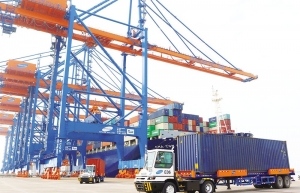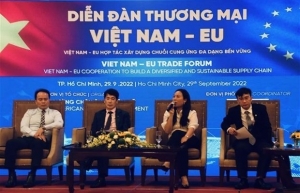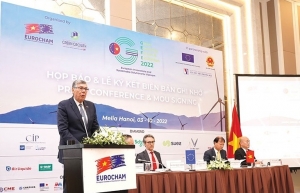Vietnam in line to benefit as EU-ASEAN deal inches closer
ASEAN and the EU last week continued underlining their strategic partnership as a cornerstone in bilateral ties, including an intent to establish an ASEAN-EU Free Trade Agreement (AEFTA) expected to further facilitate trade and investment flows between both sides.
 |
| EU member states continue to be keen on cooperation in key Vietnamese industries such as garments and textiles, agriculture, and more, photo Le Toan |
In order to make the AEFTA feasible, ASEAN and the EU have agreed to soon organise meetings on promoting mutual understanding on new trade issues such as e-commerce, public procurement, sustainable trade, and sustainable development.
In fact, plans have stalled on the AEFTA since 2009 after negotiations were launched in 2007. Instead, the EU decided to pursue bilateral FTAs with nations including Singapore and Malaysia (2010); Vietnam (2012); Thailand (2013); the Philippines (2015); and Indonesia (2016). FTAs are in effect with Singapore and Vietnam, ratified in 2019 and 2020, respectively. Negotiations are continuing with Indonesia, while talks are on hold with Malaysia, the Philippines, and Thailand.
According to the Vietnamese Ministry of Foreign Affairs’ Department of ASEAN, in September both sides agreed on boosting discussions to determine specific cooperation sectors that have the interest of both sides, such as supply chain development, e-commerce, digital economy, green technology, and green services. They also agreed to find suitable solutions to boost economic and trade.
To promote trade ties, both sides in October inked the EU-ASEAN Comprehensive Air Transport Agreement – the world’s first bloc-to-bloc air transport agreement. This is expected to usher in numerous opportunities for airlines of ASEAN and the EU to exploit passenger and cargo services between the two regions.
At present, ASEAN and EU are actively implementing the recently adopted EU-ASEAN Trade and Investment Work Programme, which will handle trade and investment obstructions between both sides, with high-level policy dialogues; consultation at the senior economic official level; enhancing dialogue with businesses; and cooperation activities that includes various projects.
Especially, this programme is focused on developing the framework and parameters of the AEFTA.
In 2021, the EU was ASEAN’s third-largest trade partner after China and the US, with a total 2-way trade turnover of $268.9 billion, up 18.6 per cent on-year. The EU was also the second-largest foreign investor of ASEAN, after the US, with total newly registered capital of $26.5 billion.
Strengthened ties
If the AEFTA materialises, Vietnamese enterprises will have an additional favourable gate to enter the EU market with preferential tariffs besides the existing EU-Vietnam FTA (EVFTA), which took effect in August 2021.
Giorgio Aliberti, Ambassador and Head of the European Union Delegation to Vietnam, said since the EVFTA became valid, the EU has had preferential access to Vietnam as a vibrant economy of almost 100 million inhabitants with the fastest-growing middle class in ASEAN and a young and dynamic workforce.
“The EVFTA has put the EU exporters and investors at least on a par with those from other countries and regions which have already concluded FTAs with Vietnam such as ASEAN, Australia, Chile, India, Japan, and the member countries of the Comprehensive and Progressive Agreement on Trans-Pacific Partnership,” Aliberti said.
Latest statistics from the Vietnamese Ministry of Industry and Trade (MoIT) show that last year, both sides’ total trade values stood at $56.8 billion – including $39.9 billion worth of Vietnam’s exports, up 13.5 per cent on-year, and $16.9 billion worth of Vietnam’s imports, up 15.5 per cent on-year.
In the first 11 months of this year, Vietnam earned a trade surplus of an estimated $29.5 billion from the EU – up 42.4 per cent on-year. Vietnam’s exports were worth $43.5 billion, up 21 per cent on-year; and imports were valued at $14 billion, down 9.2 per cent on-year.
Vietnam has, in past years, witnessed a big trade surplus with the EU, at $28 billion in 2018, $21.7 billion in 2019, $20.4 billion in 2020, and $23 billion last year.
“Vietnam enjoys a significant trade surplus with the EU – a strong indicator of Vietnam’s economic recovery post-pandemic, and growing Vietnam-EU bilateral trade,” said consultancy firm Dezan Shira & Associates.
Since the enforcement of the EVFTA, around 85.6 per cent of all tariff lines have been eliminated fully for Vietnamese commodities. This represents 70.3 per cent of Vietnam’s total exports to the EU. Such progressive elimination of import duties explains the 20 per cent on-year surge of Vietnam’s exports to the EU.
In the first half of 2022, for example, Vietnam witnessed improvements in the export value of goods to the EU, compared to the same period in 2021, with textiles ($2.13 billion – up 37.5 per cent on-year), footwear ($2.91 billion – up 19 per cent), seafood ($686 million – up 41.2 per cent), coffee (442,000 tonnes – up 42.6 per cent), and computers and electronics ($3.73 billion – up 18 per cent).
Vietnam and the EU have engaged in increasing bilateral trade for more than three decades. Both sides have been trusted partners in many areas, including economic development, trade, green economy, and peacekeeping.
Vietnam is the EU’s 15th trade-in-goods partner and the EU’s most prominent trading partner in ASEAN, besides Singapore. The country is also the 11th biggest exporter to the EU, with a share of 1.8 per cent in the overall EU’s imports value.
“Some Vietnamese key imports to the EU and the US are facing pressure in trade remedy inspections and origin trade fraud. The EU is applying some technical barriers on environment, sustainable development, and green transition – this is making it difficult for domestic enterprises to boost exports,” said an MoIT report on Vietnam’s 11-month trade situation.
According to Vietnam’s Ministry of Planning and Investment, investors from 25 EU member states have registered nearly $24 billion for about 2,250 projects in Vietnam.
Top prospects
During the European Commission’s Vice President Frans Timmermans’ February visit to Vietnam, he announced that the EU will provide the Southeast Asian country with a maximum grant of €210 million ($238 million) as non-refundable aid for Vietnam for the 2021-2024 period to consolidate and realise their bilateral cooperation in a number of prioritised areas.
The aid is intended to boost the EU’s cooperation with Vietnam in three priority areas including climate-responsive digital circular economy, responsible entrepreneurship and enhanced skills for decent employment, and strengthening governance, rule of law, and institutional reform.
“The EU stands ready to continue supporting Vietnam’s green transition and seeks deeper cooperation with Vietnam in climate areas to help realise the country’s net-zero commitments,” Timmermans said.
According to Dezan Shira & Associates, trade between Vietnam and the EU is forecast to reach new heights as the EU steadily fulfils the commitment to reduce tariff lines for various Vietnamese goods and commodities during the next 3-7 years. Investors across industries should make the best of the tariff advantage under the EVFTA to expand their business operations and exports from Vietnam to the EU.
“Potential remains for many sectors, including coffee and cashew exports to the EU. Currently, 80 per cent of cashew and coffee exported is raw as Vietnamese producers have yet to make processed cashew and coffee products that best suit EU tastes. Most importantly, the focus is on the telecommunications and electronic industries as the EU’s demand for semiconductors and components soar amid the global input shortage,” Dezan Shira said.
However, uncertainties remain for EU-Vietnam trade as the euro has depreciated recently. Tran Thanh Hai, deputy director of the MoIT’s Agency of Foreign Trade, expressed his concern about the impacts on the profit of businesses in the short term by the euro depreciation, especially enterprises engaging in contracts with payment in euros. That is, for exporters, the same amount of euros earns less in VND, thus affecting profits.
Moreover, the euro depreciation will increase inflation in European nations, which will undermine the purchasing power of consumers and result in limited expenditure on non-essential goods.
 | Evidence adds up for quality advantages within EVFTA Just two years in entry into force, the EU-Vietnam Free Trade Agreement (EVFTA) has brought large benefits to both the Southeast Asian market and the bloc of nearly 450 million people. |
 | Vietnam, EU seek to boost cooperation in green, sustainable growth Vietnamese enterprises should focus on meeting quality requirements and ensuring green and sustainable growth, experts said at the Vietnam-EU Trade Forum held in Ho Chi Minh City on September 29. |
 | EU-Vietnam sustainability cooperation on forum agenda The Green Economy Forum and Exhibition is expected to look at sustainable solutions in Vietnam to support the country in its net-zero emission path. |
What the stars mean:
★ Poor ★ ★ Promising ★★★ Good ★★★★ Very good ★★★★★ Exceptional
Related Contents
Latest News
More News
- 72 nations sign landmark Hanoi cybercrime convention (October 26, 2025 | 18:00)
- UN Secretary-General commends Vietnam’s global leadership (October 26, 2025 | 09:00)
- APEC finance ministers convene to tackle regional challenges (October 22, 2025 | 17:31)
- Rewiring global trade: ASEAN’s rise as supply chain hub (October 17, 2025 | 11:40)
- Vietnam attends first World Nuclear Week Forum in Russia (September 26, 2025 | 10:50)
- Vietnam attends 69th session of IAEA General Conference (September 16, 2025 | 10:00)
- ADB, WB pledge over 12 billion USD for ASEAN power grid, renewable energy projects (August 15, 2025 | 14:18)
- Lowy Institute proposes AI-based tobacco control solutions for ASEAN (August 15, 2025 | 14:14)
- Cloud computing policy to position Malaysia as regional hub by 2030 (August 15, 2025 | 14:11)
- Thailand, Cambodia suffer numerous cyber attacks (August 05, 2025 | 16:19)

 Tag:
Tag:





















 Mobile Version
Mobile Version